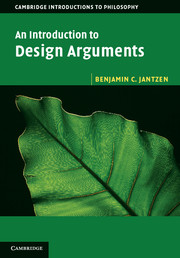Book contents
- Frontmatter
- Dedication
- Contents
- List of figures and tables
- Preface
- 1 Introduction
- 2 Preliminaries
- 3 Arguments from antiquity
- 4 Medieval arguments
- 5 The golden age of natural theology
- 6 Unusual design arguments
- 7 Hume
- 8 Paley
- 9 Darwin
- 10 Loose ends
- 11 The modern likelihood argument
- 12 Intelligent design I: irreducible complexity
- 13 Intelligent design II: specified complexity
- 14 What is complexity?
- 15 Supernatural agents and the role of laws
- 16 A brief survey of physical law
- 17 Fine tuning I: positive arguments
- 18 Fine tuning II: objections
- 19 Conclusion
- Bibliography
- Index
2 - Preliminaries
Published online by Cambridge University Press: 05 June 2014
- Frontmatter
- Dedication
- Contents
- List of figures and tables
- Preface
- 1 Introduction
- 2 Preliminaries
- 3 Arguments from antiquity
- 4 Medieval arguments
- 5 The golden age of natural theology
- 6 Unusual design arguments
- 7 Hume
- 8 Paley
- 9 Darwin
- 10 Loose ends
- 11 The modern likelihood argument
- 12 Intelligent design I: irreducible complexity
- 13 Intelligent design II: specified complexity
- 14 What is complexity?
- 15 Supernatural agents and the role of laws
- 16 A brief survey of physical law
- 17 Fine tuning I: positive arguments
- 18 Fine tuning II: objections
- 19 Conclusion
- Bibliography
- Index
Summary
Overview
In Chapter 1, we considered some of the intuitions that suggest design in the natural world. But intuitions alone are a thin justification for belief. This book is concerned with the careful, rational justification that only a good argument can provide. And history has provided plenty. Over the past 2,000 years, a great variety of arguments have been offered, each of which tries to establish that at least part of the world has been designed. But before we can capitalize on these arguments – before we are in a position to sift and weigh them, eliminating the weak and isolating the strong – we have to do a little stage setting. We need to develop a vocabulary for referring unambiguously to the parts of an argument, and for characterizing the different kinds of argument we come across. Not every sort of argument – even when successful – offers the same degree of confidence in its conclusion, and we need to be able to recognize the difference. Some of this work will be left to later chapters where fresh terminology is introduced as it is needed. In this chapter, we’ll consider a few simple design arguments based on the case studies of Chapter 1 and introduce just enough technical jargon to get us through our first set of historical arguments.
Arguments and their parts
Consider the following argument for the existence of God based on features of the parasitic wasps we considered in case study 3 of the last chapter:
Example 1
The egg-laying ovipositor of the wasp Megarhyssa is built just right to function as an efficient drill. An efficient drill could not form by chance. Since every structure is the result of design or chance, some intelligent being must have intended for the wasp to have such a drill. Therefore, there exists a being – call it God – who designed Megarhyssa.
- Type
- Chapter
- Information
- An Introduction to Design Arguments , pp. 18 - 28Publisher: Cambridge University PressPrint publication year: 2014

